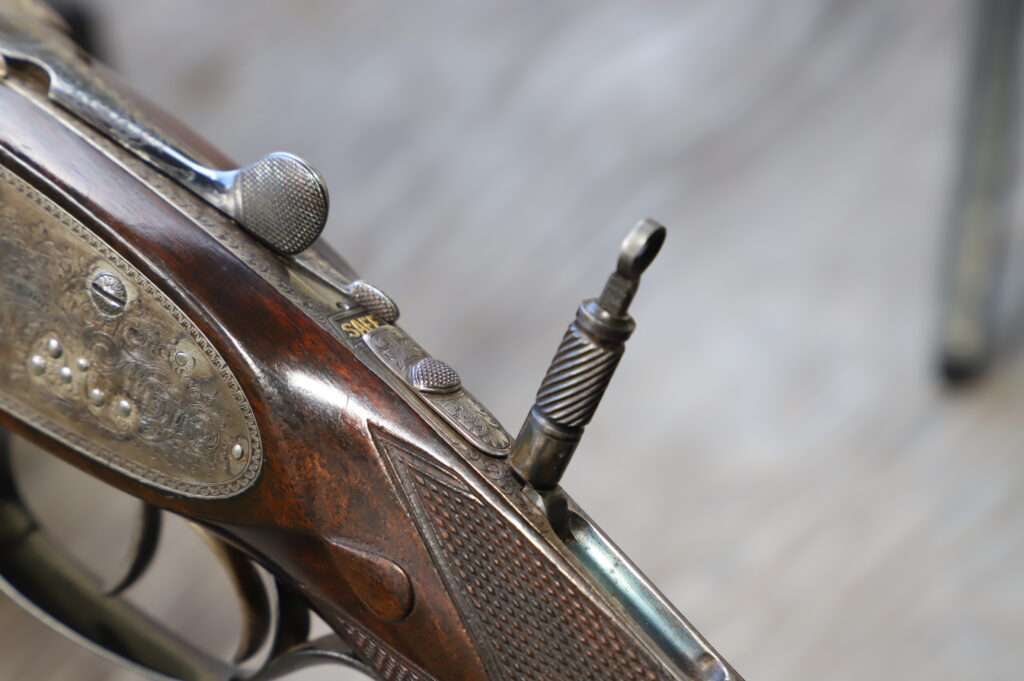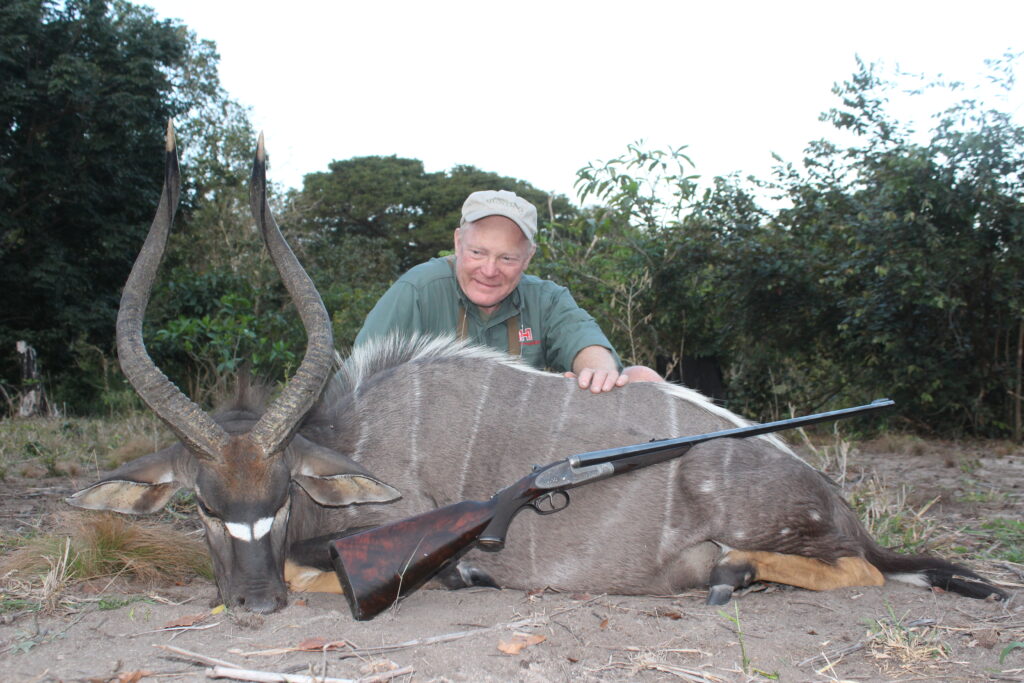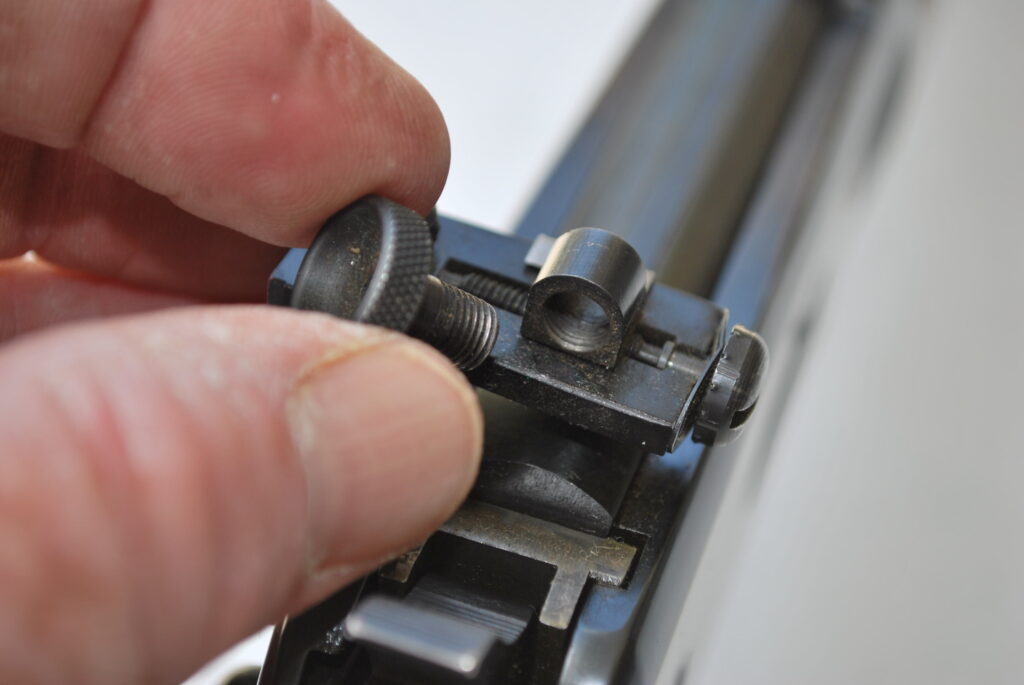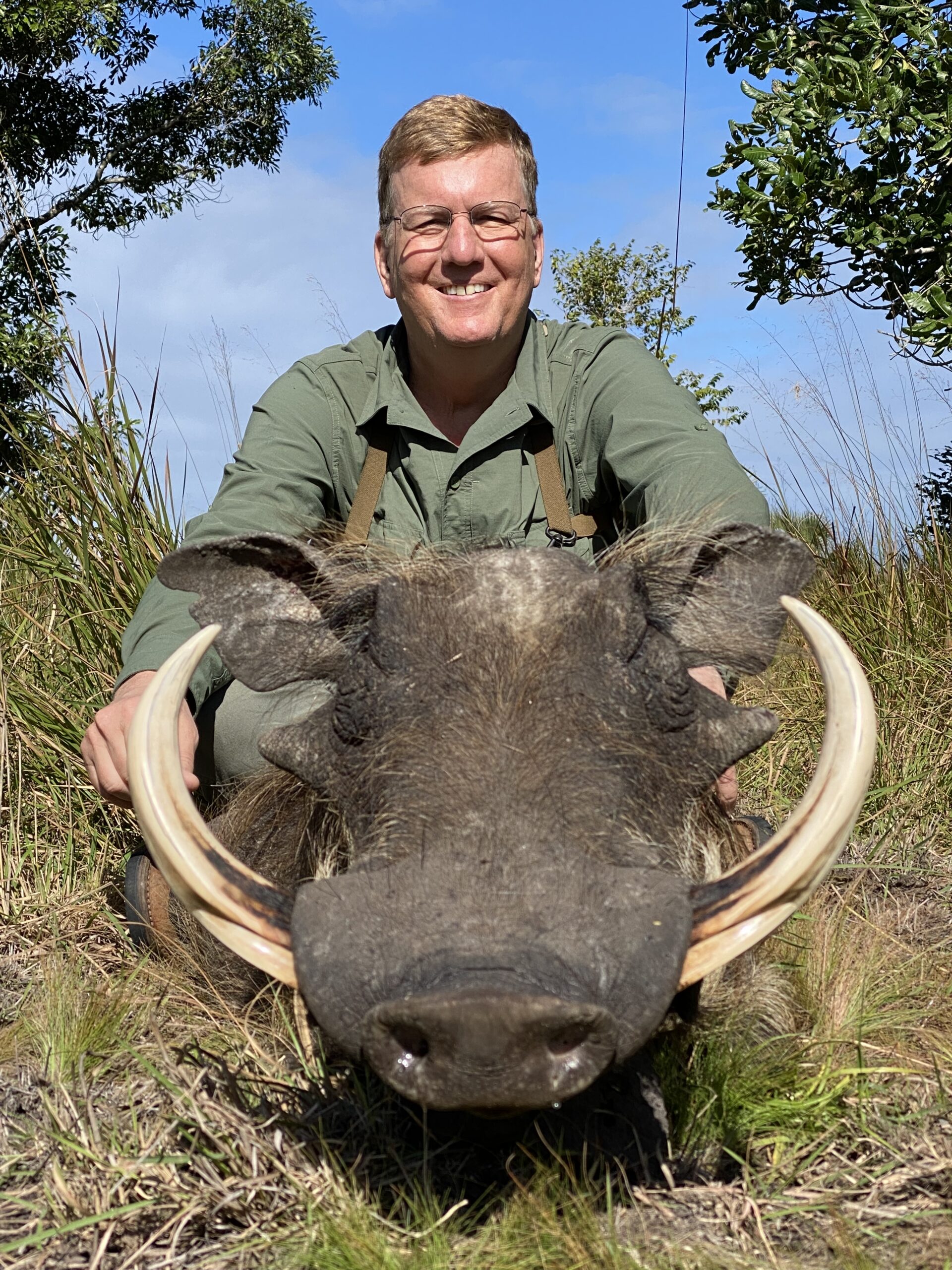Express Sights Are Classic, But Open Your Eyes To Red Dots, Ghost Rings And Others
By Craig Boddington
We have this wonderfully romantic idea that the “best” sight for dangerous game is the rock-solid “express” open sight, bold bead up front, shallow V rear. These are the sights our PHs usually have on the backup rifles they carry every day.
A bit of hero worship for our professional hunters is almost unavoidable. We admire them, we envy the lives they lead in wild places. At least a small part of us wants to be like them so, as the Africa bug populates our bloodstreams, we start to emulate them. We find ourselves hunting in shorts and gaiters, and we covet a big-bore rifle with open sights.
This is normal and harmless. Except, we need to examine why our PHs prefer open express sights. A dangerous game PH carries their heavy rifle every day of their working life. They don’t use it often, but it must be handy. Open sights make a lighter and more compact package, with less projection to snag on vines and brush. Let’s also consider the shooting a PH is most likely to do: When required, he must stop the attack of a big nasty at close range. His big rifle is the entire party’s last line of defense.
Sometimes, he may shoot to prevent the escape of a wounded animal. Express sights aren’t precise, so now it depends on distance. Up the bum of a buffalo at 60 yards as it’s vanishing into thick stuff is one thing. An animal streaking for a park boundary at 200 yards is something else. I have seen PHs make amazing shots with their express sights. In part, because that’s what they are used to, that big rifle is as familiar to them as the keyboard I’m pounding is to me. On the other hand, they’re human; I’ve seen some embarrassing misses, too.

OPEN SIGHT LIMITATIONS
So, before we plunk down cash for that express-sighted big bore we want so badly, let’s give it some thought. Many hunters my age may have started hunting with open sights. I did not. I learned to shoot with an open-sighted .22, but I did my first hunting with scopes. I was 30 before I first hunted with iron sights. Even with young eyes, I was surprised at how much more difficult it was. I had been spoiled by magnifying riflescopes. Humbled, I did a lot of practicing. I became proficient with open sights and used them quite a lot for the next 30 years.
Except for some specialized applications, by 1970 scopes were in almost universal use for hunting. My guess is that most American and European hunters my age do most of their hunting with scopes; the percentage probably goes up among younger folks.
Romantic notions aside, we do not suddenly wake up in middle age with God-given proficiency with open sights. They require a lot of practice. This isn’t so pleasant with big bores. Fortunately, a .22 fitted with similar sights will teach you everything you need to know. Unfortunately, this may not be enough, because Father Time will have his say.
Worse for some, better for others, but as we age most of us lose visual acuity. Technically, open sights have no range limitation, so long as you can resolve target and sights. However, for most of us open sights are a short-range solution. Also, they are more difficult to use in fading light and shadows. There was a time when I could shoot confidently with open sights to 200 yards. Those days are over. Today, cut that in half. If light isn’t good, cut it down some more.
REDUCING PLANES
The biggest challenge to open sights is they require the eye to focus in three visual planes: Rear sight, front sight, and target. Shortfalls in vision may be corrected, but as we get older our eyes become less flexible and less able to shift back and forth.
Before riflescopes came into common use, the aperture sight was the precision sight. The catch phrase “iron sights” includes both apertures and all open sights. In an aperture or “peep” sight, the rear sight is a circular opening. The eye looks through the rear sight, not at it, and the front sight then sits naturally in the center of the opening. So, the aperture sight reduces focal planes from three to two: Front sight and target.

The aperture sight is thus faster to acquire than an open sight, although much depends on size of the hole, that is, the actual aperture, as well as the size of the front sight. The smaller both are, the more precise, but slower to acquire. The larger, the less precise, but the faster the aim. With both open sights and apertures, larger front beads (or blades) are more visible and faster. However, they’re less precise because the larger front sights subtend, or cover, more of the target. I like apertures. That’s what we used throughout my military career, so I’m accustomed to them. I’ve used them on various lever-actions for decades, and I have an old .303 double with flip-up tang-mounted aperture. For me, the aperture has always been faster and more precise than other open sights. Today, with eyes not what they were, they are even better.
A generation back, aperture sights seemed almost obsolete. Today they’re making a comeback. Part has been the popularity of the AR platform. With a rail, you can mount any sight you want, but the standard battle sight for an AR is an aperture sight. The resurgence of lever-actions, especially the big-bore variant we call a guide gun, also has made aperture sights popular again. The type of peep sight commonly used on the big lever-actions is called a ghost ring. It has a large opening, and the eye essentially fuzzes out or ghosts the sight itself. The front sight is also big and bold. The ghost-ring is not precise, but it’s fast and visible. We’ll come back to it, but first let’s shoot down another plane.
The magic of the riflescope is that the eye needs to focus in just one plane. All we must do is focus on the target and superimpose the reticle. Magnification is just a bonus; the real value of the riflescope is it’s so much easier for the human eye. Especially human eyes that are getting older. When I was a kid, the 4X riflescope was king. Variable scopes weren’t yet perfected. Today, we have variables that offer massive magnification, with zoom range up to eight times.
We also have variable scopes that start at 1X, no magnification. In many situations, magnification isn’t needed, and we retain the major advantage of operating in just one focal plane. That is what the reflex sight is all about: One focal plane, put the dot on the target. We call it reflex because the illuminated dot is reflected into the center of the sight. We also call it a red-dot sight because red is the most common color. Today there are reflex sights with other colors but, with no color-blindness, I’m happy with the bright red dot.
Invented in Sweden in 1975, Aimpoint was the first reflex sight. Today numerous good optics firms offer them. I’ve used reflex sights from Leupold, Trijicon, Zeiss, and others, but I have the most experience with Aimpoint.
HUNTING WITH RED-DOT SIGHTS
A reflex sight is mounted like a scope and adjusted and zeroed like a scope. To move the bullet strike up, follow the up arrow, to move the strike left or right, follow the L or R arrows. An immediate advantage: Reflex sights are smaller and lighter than scopes.
In extremely close situations, as in all elephant hunting, stopping a charge, or most hunting with hounds, shooting is so close that magnification just gets in the way. Some of us are fortunate to be able to shoot magnifying scopes with both eyes open, maintaining peripheral vision. Many are not. Either way, in fast-breaking, close-range situations, with a magnifying scope, some tunnel vision is almost unavoidable — even at 1X. The reflex sight helps; it drives us to with both eyes open. Raise the rifle, superimpose the dot on the target, and take your shot.
Years ago, at one of our Conventions, Dr. Joe Greenfield, now gone, told me he’d put a reflex sight on his Holland & Holland sidelock .500/.465. I was horrified that anyone would do something like that to such a fine rifle. Well, Doc Greenfield loved that rifle, was having trouble seeing the express sights, and wanted to keep using it. I was much younger then. Recently, I’ve put reflex sights on two double rifles.
Unlike a scope, a compact reflex sight can usually be mounted low enough to have no impact on stock fit. Absent magnification, I think of the red-dot as a close-range affair. Most of my hunting with them has been for hogs and dangerous game, where I don’t need magnification. However, with practice you gain confidence, and your range envelope increases.
I put an Aimpoint with two-minute dot (subtending two MOA) on my Blaser, switching it to several barrels for different game. I put the same Aimpoint on a Sabatti double in .450-3 ¼-inch. The dot covers one inch at 50 yards. The barrels print more than an inch apart at 50 yards, so the dot is smaller than the group. Not a problem at dangerous game ranges.
The Blaser is very accurate. Whether at 50 yards (the dot covers 1 inch), or 100 yards (the dot covers 2 inches), I can put a group well inside the dot. The human eye is a marvelous instrument. Accuracy is not impeded by the size of the dot, or how much it covered: My eye shoots for center of dot.
Difficulty resolving express sights is part of getting older. Friend Tony Lombardo wanted a reflex on a pet .470 not set up for optics. Ace gunmaker J.J. Perodeau solved the problem by milling near-invisible dovetails on each side of the rib behind the front sight. J.J. put a Trijicon sight on Tony’s .470 and he loved it, so I wanted to put a reflex on our Heym .450/.400-3-inch.
Last year, Aimpoint came out with their S1 shotgun sight, which has a massive 6-minute dot. Why not? JJ worked his magic. In a few days, I had a detachable reflex on the rifle. This rifle prints both barrels side-by-side touching at 50 yards. Despite the red dot covering 3 inches on the target at 50 yards, with the reflex I get both barrels grouping together a third the size of the dot.
I just shot the first buffalo with that sight, hunting with Jose Maria Marzal of Chico & Sons. After three days of tracking, I drew a close shot. Not 50 yards, but in very thick stuff, and it needed to be fast. That big red dot was like a shining beacon on the black shoulder. The herd exploded so fast it was impossible to get in the second barrel. No worries, I was certain of the first shot. After a few seconds, we heard the death bellow, then waded in to check him.
It remains to be seen how I’ll like that extra-large dot at greater distance. Realistically, it’s a double rifle, so I’m unlikely to shoot an animal much past 100 yards. At 100 yards, a dot covering 6 inches of buffalo is not a problem.
If I planned to shoot smaller game with that rifle, I’d probably stick with a 2-minute or perhaps 3-minute dot. However, I remain convinced the eye shoots for the center, not the whole dot. With all red-dot sights, you can and must adjust the bloom or brightness to the light. As light fades, turn it down. In bright light, turn it up. Battery life tends to be ridiculously long, but there is a battery so carry a spare in your backpack.

HUNTING WITH PEEPS AND GHOST RINGS
I’ve known few African PHs who use apertures. One reason must be that they are not traditional on African rifles, although my .303 certainly isn’t the only classic British rifle I’ve seen with an aperture. Perhaps more to the point: They are usually an appendage, while the classic open express sight is almost part of the rifle.
One PH who does use an aperture is Tanzanian Michel Mantheakis, using a rugged aperture sight on his .450 Dakota. He told me a story about a wounded lion that they tracked for several days. He finally got a take-it-or-leave it shot at maybe 300 yards, got another bullet in and they recovered it. As Michel described, “The front sight covered the lion and three or four acres around it.” Awesome shot with any iron sight. For most people, not even worth attempting with an open express sight.
Some of the most demanding competitive disciplines call for precise aperture sights. However, target apertures have small openings, often matched with small front sights. These are not practical hunting sights, too slow to acquire. Older receiver aperture sights often came with at least two screw-in apertures, one with a smaller opening for precise target shooting, another with larger opening for hunting.
In the field, we often unscrewed the aperture and sighted through the hole, which remained centered and zeroed. This is probably the genesis of the “ghost ring” concept, a larger hole for fast acquisition. Again, the larger the aperture, the less precise. But less light is needed.
There’s a similar trade-off with the front sight. The smaller the front sight, the more precise the aim, and less of the target covered. But it’s slower to acquire, and more light is required to resolve it well. When ordering a bead front sight, whether for use with peep or open sights, I specify a 3/32-inch bead. For me, this is nice and bold, and that’s what I put on my old lever-actions. I have a Big Horn Armory M89 Spike Driver in .500 S&W. It was supplied with the excellent Skinner ghost ring aperture, and a bold white front bead. It is 3/32, or .094-inch. I shot a black bear with it a week ago, close shot but with bears on bait, the light is rarely excellent. That bead was bright and clear. No problem.
I’ve been hunting a lot with that .303 double, a nice old H&H. The front sight is so tiny as to be almost invisible to me. However, like a lot of older doubles, it has a flip-up “moon” or night sight with a larger bead. It measures .125, 1/8-inch. It’s highly visible, so that’s what I’m using for hunting. Probably too large for precision, but it’s easy to see, and I’m not going to shoot far with that rifle anyway.
I like the Skinner ghost ring, adjustable by screwing the aperture up or down (up to move the strike up), then tightening a set screw to hold it. XS Sights makes a host of aperture and open sights, now supplied by numerous manufacturers. Ruger uses an XS ghost ring on the new Ruger-Marlin 1895 .45-70. It’s a good and rugged sight, also is also easily adjustable. Rather than a bead, the XS front sight is a thick blade with highly visible tritium strip. Not as traditional as a bold white bead but even easier to see.

There’s nothing wrong with sticking with the traditional open express sight, provided you’ve practiced with them a lot and understand the limitations. Also, there’s no shame in using a scope. Zimbabwe PH Andrew Dawson once told me that be believed hunters who insisted on using open sights for buffalo were giving up as much as 60 percent of potential shots.
Provided you can see them, there are places where open sights are superior: Elephant hunting, deepest jungle, hound hunting, stopping a charge. But, day in and day out, most of us, especially those of us getting up in years, are best served by a variable scope with low-magnification setting that is very low. On the other hand, some of us like both the concept and reality of getting close to our game. The reflex sight is probably the best compromise right now, but don’t overlook the ghost ring aperture with a bold front sight. Either will help you recover many of those shots you’re giving up to open sights.
Col. Craig Boddington is an author, hunter and longtime SCI member. He is past president of the Los Angeles Chapter, a decorated Marine and C.J. McElroy Award winner.




